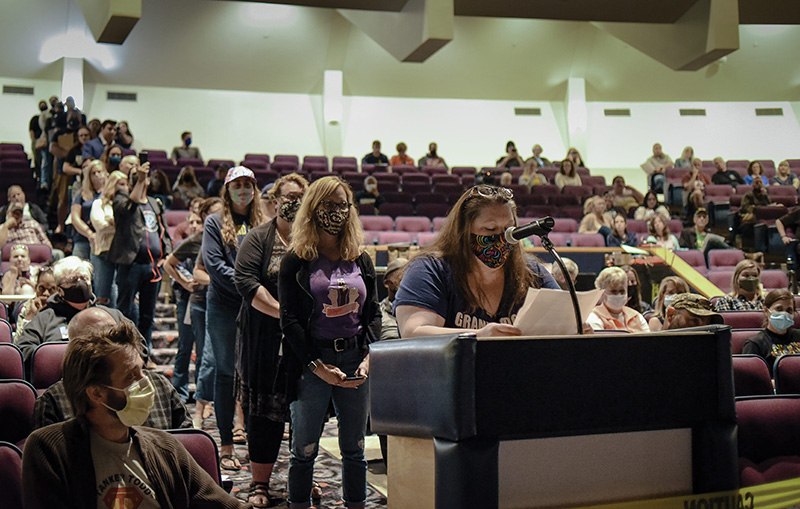
To anyone who knew of and studied Critical Race Theory (CRT) before, say, 2020, the current hysteria over the concept in American political and educational circles is both astounding and odd. Race relations, racial inequality, and racial injustice have been part of mainstream discourse in the U.S. for centuries, and yet suddenly CRT â which is nothing more than a lens through which to study and explain Americaâs racial past and present â has become a political catch-all and cudgel used to allege that âlefty academic elitistsâ want to teach white people to hate themselves, their ancestors, and their country.Ìý
Can we just stop the gaslighting?Ìý
In reality, no CRT theorist has any interest in such outcomes. Those who promulgate this mischaracterization of CRT, on the other hand, really do have a damaging agenda â to silence discussion about the oppression of marginalized groups of people from any perspective that doesnât align with Eurocentrism. Actual CRT is mainly a theoretical framework for university-level social, legal, and historical analysis, but Fox News personalities and many conservative politicians now cry âCRTâ every time a less-than-sterling element of U.S. history is included in public school curricula.Ìý
As a parent, a consultant to many school districts across Michigan, and a lifelong educator, I know of no K-12 classroom where any teacher is explicitly teaching CRT. Further, one would be hard-pressed to find a classroom or school anywhere where educators tell students that one racial group is superior to another or that students with a specific racial identification should feel guilty about their heritage. Instead, thousands of teachers across the U.S. are striving to instill in young people the ability to engage in productive, congenial, cross-cultural interpersonal and working relationships and to bring those skills â and a broadened awareness â to bear in a world where inequalities and inequities are a fact of life. How else can we hope to prepare young people of all cultural backgrounds to enter the labor market and participate in the global economy?Ìý
I went to grade school from the late 1970s to the early 1990s in a mostly white suburb of Atlanta where few of my teachers looked like me and the textbooks seldom showed people of color as anything other than inferior stereotypes. The curriculum also led most children consciously or unconsciously to perceive that white people, men, and the wealthy were superior to people of color, women, and those living in poverty. Additionally, the narratives about U.S. history and world history were told from a Eurocentric perspective that lacked any serious effort to explain the roots of social injustices experienced by women, Blacks, Indigenous peoples, and the economically disadvantaged.
I had to wait until college to gain a more complete understanding of the ways social policy and practices perpetuate marginalization. Postsecondary education afforded space for critical dialogue and debate with people who did and did not share my cultural identities and worldviews. Such conversations should have occurred sooner and in developmentally appropriate ways.Ìý
As a mother of three Black daughters, I want more for them. They should be able to engage in conversations with culturally diverse peers that push their thinking and allow them to be open to a range of perspectives. Donât we want our children to live their full humanity, think critically for themselves, and build a stronger democracy? If so, why do we want to shield them from the full truth of U.S. history, seen from a variety of perspectives?
Public education exists to teach children the skills they need to be productive members of a democratic society. As such, we must empower teachers to create learning environments where collaboration, creativity, critical thinking, flexibility, and global and cultural awareness are assets to be cherished.
Canât there be more than one perspective through which we explore the facts of historical and contemporary events? How else can we explain the vast differences in experience and fortunes for some groups in American society versus others? How can teachers explain Black Lives Matter or the murder of George Floyd without putting them into a historical context? Todayâs political right, it seems, would prefer that we just donât.Ìý
We need to move beyond the smokescreen created by this CRT debate and redirect our focus to helping our children consider multiple perspectives on racial justice and other critical issues that develop their capacity to be real thought leaders and change agents of the future.Ìý
Dorinda J. Carter Andrews is the chair for the Department of Teacher Education at Michigan State University and a professor of race, culture, and equity.
This story is featured in the October 2021 issue of Â鶹·¬ºÅ Detroit magazine. Read more stories inÌýour digital edition.Ìý
|
| Ìý |
|








